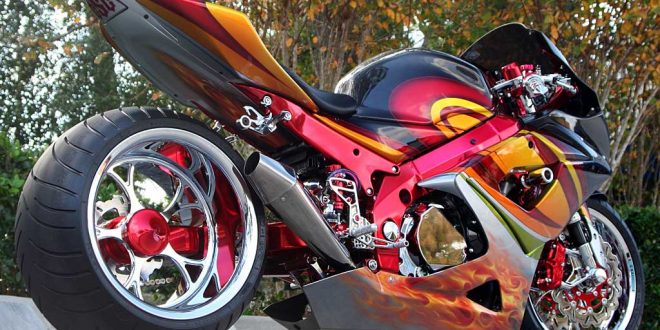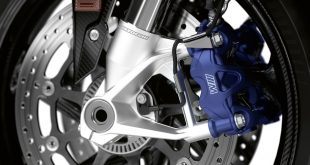So last week we briefly looked at basic mods that most riders undertake on their bikes; this week I thought I’d delve a little deeper into the process of improving handling, braking, and the all important bragging rights of horsepower! The first two aspects are fairly simple and can be fairly universally carried out on most bikes, however getting better power to the rear tire can be different depending on your bikes age, style, and engine configuration. Let’s start with the simple stuff!

To improve handling, two things play a huge role in the bikes stability – tires, and suspension. Rubber will keep your bike pointed in the right direction, and good suspension will keep the rubber in contact with the ground. Tires are easily upgraded, there are so many manufacturers out there that are all making high quality black hoops, they are fairly common knowledge. I use Dunlop on my bike, but you might like Continental, Metzeler, Michelin, Bridgestone, or Pirelli, to name a few. Any reputable bike shop can supply and fit these for you. Pretty easy, really.

Suspension is a little more complicated. If you’re riding a newer sportbike, you may find your forks and rear shock may already be fully adjustable – preload, rebound and compression damping – but if you’re riding an older bike or a cruiser, you may not. One thing to remember is that every bike and every rider will have different preferences when it comes to suspension settings. If, like me, you ride a bike that doesn’t have any way of adjusting the forks and shock, there are still ways of ‘tweaking’ it to feel a little better. Adding or removing a little bit of fork oil with make the front end slightly firmer or softer; changing out the springs for different rated items will also change the handling. And if you’re really technical, you can change the internal valving, which is a way of altering how fast or slow the oil will flow through the passages of the fork or shock, adjusting the mechanical dampening of the suspension. Thicker or thinner weight oil will also change things! Do your research, and work out what you can do before spending large amounts of money upgrading to high end branded gear. Ohlins is a great brand for top end suspension equipment, among others of course. Talk to your suspension specialist to figure out what will work for you!

To improve brake feel, the first thing most riders will do is upgrade brake pads. There are different compounds available for most bikes – organic, sintered, carbon ceramic, etc. Most bikes come with organic pads from the factory (except high end sportbikes, again), and simply changing out the pads for sintered items can make a huge difference in braking performance. If you want to go one step further, you can fit braided brake lines to your bike, which will make the brake lever feel more directly linked to the actual brakes, minimizing the squishy feel that rubber lines sometime suffer from. To put it simply, the braided lines won’t stretch under pressure, ensuring the brake fluid goes into the brake caliper and pad, rather than expanding the brake hoses. Of course, you could upgrade calipers to units with more internal brake pistons, which tend to be bigger than factory calipers, but the cost can be a big factor. A lot of riders may also change the brake discs to a higher quality material, as well as upgrading their master cylinders, but again such changes come with big cost. Brembo are generally considered to be the best in the business for braking solutions, and with good reason. Their stuff just plain works. Information can be gathered from reputable bike workshops on your specific machine.

Now, the tricky part – how to coax more horsepower from your motor… This part is much more complicated because of the different types of engines, and the different ways that they deliver fuel and air into the combustion chamber. Generally speaking, if you want a LOT more power, you are best off buying a bigger bike. But, if, like me, you love your little 250cc carburetted bike, there are ways of maxing its potential. Start with a good free flowing exhaust and intake, and get it tuned for the changes. Every little thing you do will affect the air-fuel ratio, so spend time and money on a dyno with a good engine tuner to make it all work together efficiently. If you are comfortable pulling the motor down, you can change camshafts, port and polish the cylinder heads, or even bore the cylinders out and fit larger pistons. All of which will reap small improvements in power numbers, but you’re not going to make your 250cc as fast as a 1000cc bike, regardless of how far you take it. The other thing to consider is reliability. If you stress the motor too much, it’ll go bang and you won’t like it. Be reasonable with your engine modifications. Again, this is specialist work and not cheap, but can be rewarding if you know what you’re doing!

There are a lot of other things you can do to make your bike ‘your own’, like custom painted fairings, aftermarket levers and rearsets (footpegs), or even aftermarket digital gauges, but I think we have covered the basics here. If you’d like to know more about how to change the ‘look’ of your bike, or if you have any questions about todays topic, comment below! We’d love the feedback! Ride safe!
– Scott
Latest posts by (see all)
- I’m Starting To Get Good At This!! – Tauranga Harbour on the Viking Profish 400 - March 17, 2021
- Success On The Viking Yak! - February 21, 2021
- First Fishing Trip on The Viking Yak || Army Bay - February 8, 2021
- How To Make Kayak Wheels For $27.00! - February 1, 2021
 THE EMPIRE
THE EMPIRE





